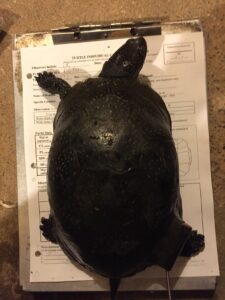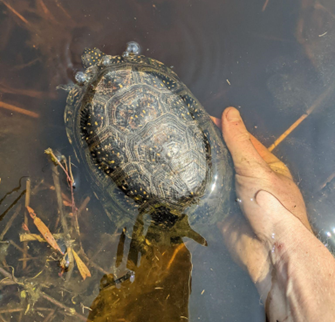This week’s post comes to you courtesy of ZNE’s Field Biologist, Jimmy Welch.
What do you do when you lose a turtle? We often talk about radiotracking turtles, using an antenna and radio receiver to follow their movements. On the surface, the concept seems straightforward enough. You attach a radio to the turtle’s shell and then you follow the signal; as you get closer, the “beeps” on your radio get louder until you eventually find the turtle. But what about when you go looking for a turtle you expect to be nearby and you can no longer hear those beeps at all? That is when the mystery begins. When this happens, there are two possibilities:
1) The radio may not be functioning properly; maybe it broke or the battery died before we expected it to, in which case we often lose track of the turtle entirely, or,
2) The turtle has moved far enough away from its last location that we just aren’t able to hear the signal anymore. Most of our radios can be picked up from a half-mile away or so, but if a turtle moves farther than that, the signal will be too weak to pick up.

A great example of this recently happened with one of our wonderful Blanding’s turtles. This is one of our adult females who we tracked from 2012 to 2018 before she mysteriously disappeared. Her nest had been protected for several years and she was a well-known turtle that seemed loyal to an area of one of the wetlands within the site. This year we were fortunate enough to encounter her near her known nesting habitat, thanks to an observant neighbor who reported the sighting to our turtle nesting hotline. She even had her old radio still attached that had stopped working years ago when she disappeared! So, we removed the radio and put on a new radio to begin tracking her again.

However, the mystery continued when her radio signal could not be heard from anywhere around her home wetland again this year. We decided to explore the surrounding area to see if there was a chance she moved to a new location. So we ventured upriver by canoe to see if we could locate her signal. Just as we began to lose hope, a faint beep was heard from our radio trackers. Could this be her? We confirmed that it was indeed number 2042’s signal but the adventure was far from over. From where we were on the river we could tell by the faintness of the signal that we were not close to her. Our best bet would be to paddle back downstream and drive over to the area where the signal was heard. So we drove over to another local conservation area and were able to pick up a stronger signal. From there we began to traverse the wetlands, behind homes and farms, and eventually pinpointed her location within a shrub covered marsh. Walking through to find her proved to be quite challenging but we eventually reached her in the center of the wetland. Finally we caught her and the mystery was solved. We believe that a similar movement could have been the reason she was lost in 2018.
This capture is particularly interesting because we suspected that she may have nested in the neighborhood near this wetland based on reports and some photos a homeowner took of a nesting Blanding’s turtle in their yard. If that is true, then this female nests in multiple areas. Many of our nesting females are loyal to their nesting sites and nest in similar areas or even the exact same yard year after year, but some like this female may nest in several different locations. It was an exciting capture and gives us not only great data on this specific female but also movements of turtles within the population and how they are using the broader environment surrounding the site. The spot she was finally found was about 1.25 miles from her previous location.

Turtles move and disperse across their environment much like many species. They may start in one area or population but move to new places for a variety of reasons. We are not sure why this specific female made this large movement but it is common for many of the turtles to spend time in different locations throughout the year. Usually movements are smaller but we have seen similarly large movements in individuals of several turtle species we work with including Blanding’s turtles, box turtles and wood turtles. Studying these unusual movements can tell us a lot about our turtle subjects!
